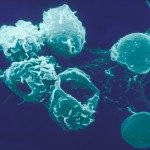Lien vers Pubmed [PMID] – 36869420
Lien DOI – 10.1111/imr.13187
Immunol Rev. 2023 May;315(1):54-70
During embryonic development, several independent generations of hematopoietic cells were identified. They occur in the yolk sac and the intra-embryonic major arteries, in a narrow window of development. They arise sequentially, starting with primitive erythrocytes in the yolk sac blood islands, progressing to less differentiated erythromyeloid progenitors still in the yolk sac, and culminating with multipotent progenitors, some of which will generate the adult hematopoietic stem cell compartment. All these cells contribute to the formation of a layered hematopoietic system that reflects adaptative strategies to the fetal environment and the embryo’s needs. It is mostly composed, at these stages, of erythrocytes and tissue-resident macrophages both of yolk sac origin, the latter persisting throughout life. We propose that subsets of lymphocytes of embryonic origin derive from a different intra-embryonic generation of multipotent cells occurring before the emergence of hematopoietic stem cell progenitors. These multipotent cells have a limited lifespan and generate cells that provide basic protection against pathogens before the adaptive immune system is functional, contribute to tissue development and homeostasis, and shape the establishment of a functional thymus. Understanding the properties of these cells will impact the understanding of childhood leukemia and of adult autoimmune pathology and thymic involution.






